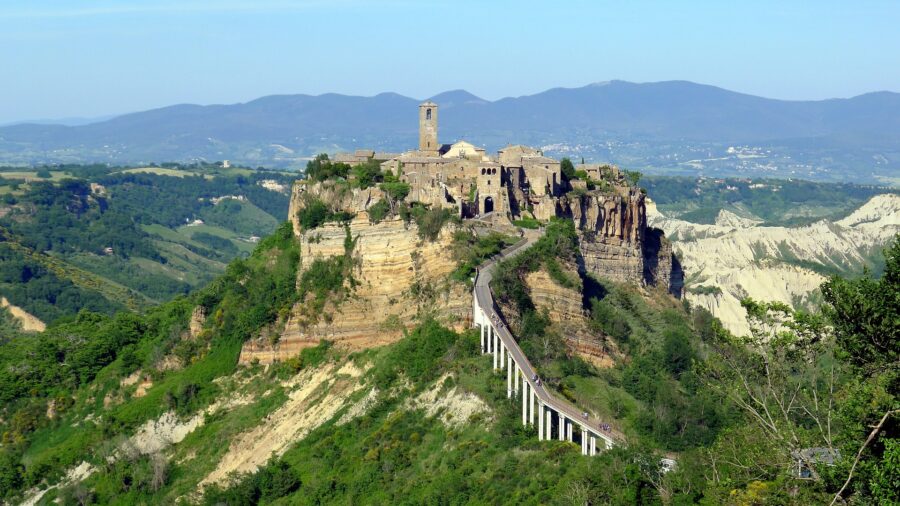
Bagnoregio – the dying village
In a remote region of Italy, on the border between Lazio and Umbria, a village perched on a tufa hill is one of the most beautiful in the country. Civita di Bagnoregio can only be reached via a 250-metre-long footbridge that spans a deep gorge.
Despite its idyllic location, Bagnoregio is a dying village. The remoteness, the danger of earthquakes and the lack of prospects made most of the inhabitants migrate. Before the turn of the millennium, only a handful of unswerving people still lived in the medieval gem that would make the perfect backdrop for a fantasy film.
But recently there has been hope that Civita di Bagnoregio’s time is not yet coming to an end. Local politicians and artists founded an initiative to save the village. The plan is to apply for Bagnoregio to be included in the UNESCO World Heritage List.
Bagnoregio: a backdrop fit for a film
Visitors entering Civita di Bagnoregio for the first time seem to be transported into the fantasy world of “Games of Thrones” or “The Witcher”. The city walls, the narrow streets and the medieval towers tell the story of a city that has preserved its identity and its history. It is a place that invites you to travel back in time to a bygone era and gives you an impression of Italy’s rich cultural heritage.
Narrow alleys lead behind the city walls to Piazza San Donato, where the church of the same name rises. It was a cathedral and bishop’s seat for over 1,000 years until an earthquake in 1695 caused great damage. The bishop then moved his seat from the village on the tufa hill to the main town on the plain.
The dying village
Civita di Bagnoregio was once a proud town until the earthquake of 1695 caused a significant break in its history. Founded 2,500 years ago by the Etruscans, the city has seen many rulers come and go. During the earthquake, such powerful forces acted that a wide gorge tore open, separating the old settlement core from the rest of the city. Most of the inhabitants then left their homes and followed the bishop down to the plain. The civita fell into disrepair and by the 1990s only a dozen people lived behind its medieval walls.
Resurrection as a tourist destination
Plans to have Civita di Bagnoregio added to the UNESCO World Heritage List have brought the dying village back into the public eye. In the summer months, tourists flock to the picturesque village, and in some cases entrepreneurs offer bus tours from surrounding towns to Bagnoregio. In 2013, an entrance fee was introduced for day visitors and life is slowly returning to the abandoned village on a permanent basis.
Medieval houses as second homes
An ex-manager from Rome gave the go-ahead for a new beginning in Civita di Bagnoregio at the beginning of the 1990s. The manager, several artists and wealthy residents of the capital began to repair the dilapidated buildings and set up second homes behind the time-honoured walls. Concerts are now played in the church and, until the outbreak of the Corona pandemic, a US university held summer courses in Bagnoregio. There is now a small hotel, cafés and restaurants.
When the daytime visitors have left the dying village in the late afternoon, calm returns to the alleys around the Piazza San Donato. With a little imagination, you can hear the clatter of horses’ hooves on the stone pavement and the clank of knights’ swords. Then Bagnoregio is once again the setting that would have done honour to a fantasy or history film.
